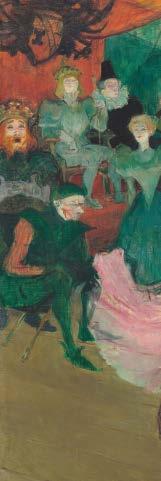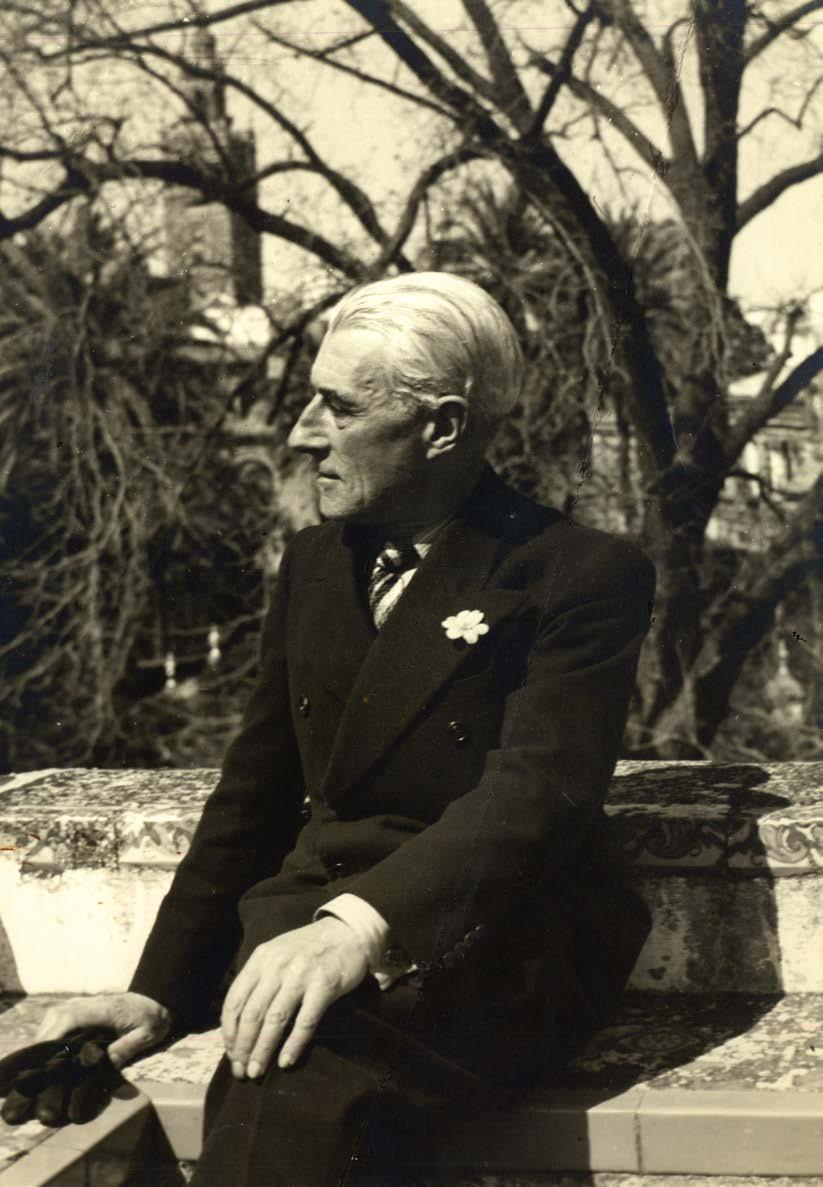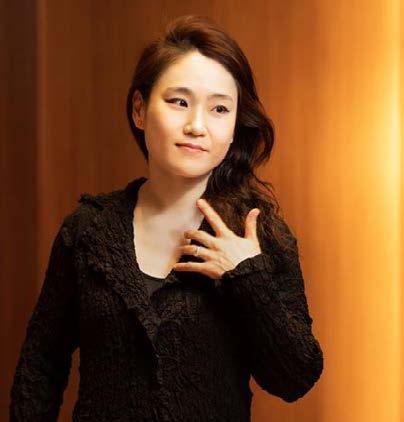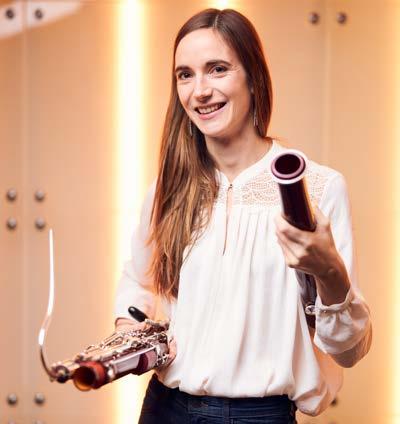

Regarding Ravel Fri 7 March 2025 • 20.15 Sun 9 March 2025 • 14.15



Regarding Ravel Fri 7 March 2025 • 20.15 Sun 9 March 2025 • 14.15
conductor Han-na Chang
bassoon Lola Descours
Maurice Ravel (1875–1937)
Pavane pour une infante défunte (1899/1910)
André Jolivet (1905–1974)
Concerto for Bassoon, String Orchestra, Harp and Piano (1958)
• Recitativo
• Allegro joviale
• Largo cantabile
• Fugato
Maurice Ravel Boléro (1928)
intermission
Sergey Prokofiev (1891–1953)
Symphony No. 5 in B-flat major, Op. 100 (1944)
• Andante
• Allegro marcato
• Adagio
• Allegro giocoso
Concert ends at around 22.30
Most recent performances by our orchestra:
Ravel Pavane: Sep 2020, conductor Valery
Gergiev
Jolivet Bassoon Concerto: first performance
Ravel Boléro: Oct 2022, conductor Bertie Baigent
Prokofiev Symphony No. 5: Sep 2018, conductor Lahav Shani
One hour before the start of the concert, Kees Wisse will give an introduction (in Dutch) to the programme, admission €7,50. Tickets are available at the hall, payment by debit card. The introduction is free for Vrienden.
Cover: The Trocadéro Carousel in Paris, photo Halanna Halila (Unsplash)



Maurice Ravel was born on the 7th of March 1875. In this concert we celebrate his 150th birthday with his most beloved music, combined with works by two of his friends and colleagues.
In his younger years, Maurice Ravel regularly visited the salon of Winnaretta Singer, Princesse Edmond de Polignac, co-heir to the Singer sewing machine fortune and a great music lover. In 1899, she asked Ravel for a piano work. The Pavane pour une infante défunte (‘Pavane for a deceased Spanish princess’) that he wrote for her, became an immediate success. Wherever Ravel went, people asked for ‘the’ Pavane – at which point the composer would have to explain that he hadn’t been thinking of a recently deceased noblewoman in mind, but a princess from the distant past. Ravel was initially delighted with the success of the miniature and in 1910 he orchestrated it. However, as he grew older, it began to bother him that this particular piece remained a favourite, while many other beautiful works went unnoticed. Truth be told, it is a very strong work. The beautiful, moving melody pairs emotional depth with comforting tenderness. And the wonderful orchestration casts the melody in an ever-changing light – a technique Ravel would later take to the extreme in his Boléro.
André Jolivet grew up immersed in Ravel’s music, but soon turned his attention to innovators such as Arnold Schönberg and Edgard Varèse, whose only European student he would become. Jolivet’s early music is quite complex, but he ultimately felt out of place with the hermetic and mechanical nature of avant-gardism. In response, he founded the group ‘La jeune France’ in 1936 with Olivier Messiaen and two other colleagues, to advocate a more human and spiritual, and less abstract music. During the Second World War his compositions became more tonal, lyrical and simple. But he did not really like that extreme end of the musical spectrum either: within that simplicity he could not express himself sufficiently. In his Bassoon Concerto Jolivet found the perfect middle ground between lyrical simplicity and complexity. The highly virtuosic concerto begins with a long recitative in which the bassoon - increasingly agitated - shows what the instrument is capable of. The monologue transitions into a playful Allegro giovale full of syncopations, in which the jazz so beloved by Ravel is never far away. The Largo cantabile is lyrical, colourful and deeply moving. Here too, the jazz is always present, the bassoon at times takes on an almost saxophone-like sultry sound. The largo flows into a Fugato that slowly builds in intensity: initially restrained, but growing ever more exuberant, as the orchestra and soloist hurtle toward a dazzling, adrenaline-charged conclusion.
De adrenaline giert ook door de Boléro, a piece Ravel wrote for Ida Rubinstein. The UkrainianFrench ballerina and choreographer had requested a ballet piece, and Ravel responded with his most daring musical experiment. He famously described it as “just orchestral texture without music.” Ravel, whose mother was Spanish, chose a Spanish dance rhythm as a basis and built an extended, unrelenting crescendo. He constructed the piece with two simple melodies, repeated over and over with constantly shifting orchestrations. Over the course of eighteen episodes the music swells very slowly, almost imperceptibly, until it finally bursts apart in a dramatic climax. The overwhelming success of Boléro continued to astonish Ravel throughout his life. Yet anyone who experiences it live understands live why: the music is hypnotic, relentless and utterly addictive.
How often must Sergei Prokofiev have thought back to his carefree days in Paris? In the early 1920s he was hailed as a brilliant young composer, mingling with the beau monde and forging friendships with artists like Maurice Ravel. But twenty years later, his life looked very different. Prokofiev had returned to Russia, where Stalin ruled with an iron fist. Defying the regime’s artistic guidelines meant risking one’s life. Prokofiev witnessed this brutality firsthand. In June 1939, his close friend, director Vsevolod Meyerhold, was arrested by Stalin’s secret police. Meyerhold was about to stage Prokofiev’s opera Semyon Kotko, but was executed, having fallen prey to Stalin’s hatred of avant-garde art. Prokofiev had been warned. He had no choice but to succumb to the tyranny. That same year he wrote the celebratory cantata Zdravitsa for Stalin’s sixtieth birthday - a temporary safeguard for his life and career. After Hitler
invaded the Soviet Union in June 1941, prominent Soviet artists were evacuated, first to Tbilisi, later to the even more remote Alma-Ata. Prokofiev was allowed to go to these far-away corners, where he could compose in relative peace.
In 1944 he returned to Moscow. The tide of the war had turned, and Soviet victory seemed inevitable. Yet, even as the end of Nazi Germany loomed, the shadow of Stalin’s renewed terror cast a grim pall over any sense of hope. It was in this complex emotional landscape – a mixture of despair, fear, and fragile optimism – that Prokofiev composed his Fifth Symphony. He described the work as “A hymn to the free and happy man, his mighty powers, his pure, noble spirit.” And that is how it initially felt during the premiere. Prokofiev conducted himself; as he raised his hands to begin, the guns roared, driving the Germans away. Prokofiev waited until the violence had died down and continued the concert, toward victory. At first glance, the symphony seems lyrical, bright, and patriotic. But beneath the surface, lies something far more complex. The second movement is laced with dark, sarcastic commentary. The slow movement, which at first suggests light and hope, ultimately crushes any optimism with brutal finality. And the finale, echoing Ravel’s Boléro, spirals into a frenzied, maniacal grimace. It is the music of two worlds.
Alexander Klapwijk

Born: Suwon, South Korea
Education: Cello and conducting at the Juilliard School of Music, New York; mentors: Mischa Maisky, Mstislav Rostropovich and Giuseppe Sinopoli
Breakthrough: at age 11, winning First Prize and Contemporary Music Prize at the Rostropovich International Cello Competition in Paris
Current position: Chief conductor Trondheim Symphony Orchestra, Norway; principal guest conductor Symphoniker Hamburg
Previously: Chief conductor Qatar Philharmonic Orchestra; founder and artistic leader Absolute Classic Music Festival South Korea
Conducting breakthrough: 2014, with the Qatar Philharmonic at the BBC Proms
Guest appearances: Berliner Philharmoniker, Staatskapelle Dresden, Philharmonia Orchestra, Stockholm Royal Philharmonic Orchestra, Royal Concertgebouw Orchestra, Symphony Orchesras of Boston, Philadelphia, Chicago, Toronto, Singapore
Debut Rotterdam Philharmonic: 2022
Born: Reims, France
Education: First bassoon lessons with JeanFrançois Angelloz; Conservatoire de Paris (CNSMDP) with Marc Trenel, further studies with Dag Jensen and Gustavo Nunes
Awards: Winner IDRS Young Competition
Birmingham 2009, laureate Crusell Competition Finland 2011, Lodz Competition
Poland 2011, IDRS Competition Spain 2019
Breakthrough: Winner International Tchaikovsky Competition 2019
As a soloist: Concerts with Yomiuri Nippon Symphony Orchestra and Mariinsky Orchestra
Chamber music: Founder Cocteau Trio and Trio ABC
On cd: Bassoon Steppes, Orchid Classics 2022 (***** Das Orchester)
As a teacher: Amsterdam Conservatory and Pôle supérieur de Aix-en-Provence, masterclasses in Italy, Switzerland, Chile, Colombia, France and Germany, coach at the Verbier Festival and the French Youth Orchestra
With the Rotterdam Philharmonic since: 2022

Proms: Spring Is in the Air
Sat 15 March 2025 • 20.30
violin/leader Ilya Gringolts
Piazzolla Cuatro estaciones Porteñas
Vivaldi The Four Seasons: Winter Westhoff Imitazione delle campane
Vivaldi Violin Concerto in D minor, RV 237
C.Ph. E. Bach Sinfonia in G major
Sun 16 March 2025 • 14.15
conductor Roderick Cox
piano Alexander Gavrylyuk
Strauss Don Juan
Grieg Piano Concerto
Dawson Negro Folk Symphony
Fri 21 March 2025 • 20.15
conductor Yannick Nézet-Séguin
soprano Angel Blue
Strauss Vier letzte Lieder
Bruckner Symphony No. 3
Fri 28 March 2025 • 20.15
Sat 29 March 2025 • 20.15
conductor Joe Hisaishi
harp Emmanuel Ceysson
Hisaishi Adagio for Strings and two Harps
Hisaishi Harp Concerto
Ravel La valse
Hisaishi Spirited Away Suite
Do you have a moment? You can help us by leaving a Google review. It will only take a minute: scan the QR code below and let us know what you think of our orchestra. Thank you!

Chief Conductor
Lahav Shani
Honorary Conductor
Yannick Nézet-Séguin
Principal Guest Conductor
Tarmo Peltokoski
First Violin
Marieke Blankestijn, concertmaster
Tjeerd Top, concertmaster
Quirine Scheffers
Hed Yaron Meyerson
Saskia Otto
Arno Bons
Rachel Browne
Maria Dingjan
Marie-José Schrijner
Noëmi Bodden
Petra Visser
Sophia Torrenga
Hadewijch Hofland
Annerien Stuker
Alexandra van Beveren
Marie Duquesnoy
Giulio Greci
Second Violin
Charlotte Potgieter
Frank de Groot
Laurens van Vliet
Elina Staphorsius
Jun Yi Dou
Bob Bruyn
Eefje Habraken
Maija Reinikainen
Babette van den Berg
Melanie Broers
Tobias Staub
Sarah Decamps
Viola
Anne Huser
Roman Spitzer
Galahad Samson
José Moura Nunes
Kerstin Bonk
Janine Baller
Francis Saunders
Veronika Lénártová
Rosalinde Kluck
León van den Berg
Olfje van der Klein
Jan Navarro
Cello
Emanuele Silvestri
Joanna Pachucka
Daniel Petrovitsch
Mario Rio
Eelco Beinema
Carla Schrijner
Pepijn Meeuws
Yi-Ting Fang
Killian White
Double Bass
Matthew Midgley
Ying Lai Green
Jonathan Focquaert
Robert Franenberg
Arjen Leendertz
Ricardo Neto
Javier Clemen Martínez
Flute
Juliette Hurel
Joséphine Olech
Manon Gayet
Flute/Piccolo
Beatriz Baião
Oboe
Karel Schoofs
Anja van der Maten
Oboe/Cor Anglais
Ron Tijhuis
Clarinet
Julien Hervé
Bruno Bonansea
Alberto Sánchez García
Clarinet/ Bass Clarinet
Romke-Jan Wijmenga
Bassoon
Pieter Nuytten
Lola Descours
Marianne Prommel
Bassoon/ Contrabassoon
Hans Wisse
Horn
David Fernández Alonso
Felipe Freitas
Wendy Leliveld
Richard Speetjens
Laurens Otto
Pierre Buizer
Trumpet
Alex Elia
Adrián Martínez
Simon Wierenga
Jos Verspagen
Trombone
Pierre Volders
Alexander Verbeek
Remko de Jager
Bass Trombone
Rommert Groenhof
Tuba
Hendrik-Jan Renes
Percussion
Danny van de Wal
Ronald Ent
Martijn Boom
Harp Albane Baron